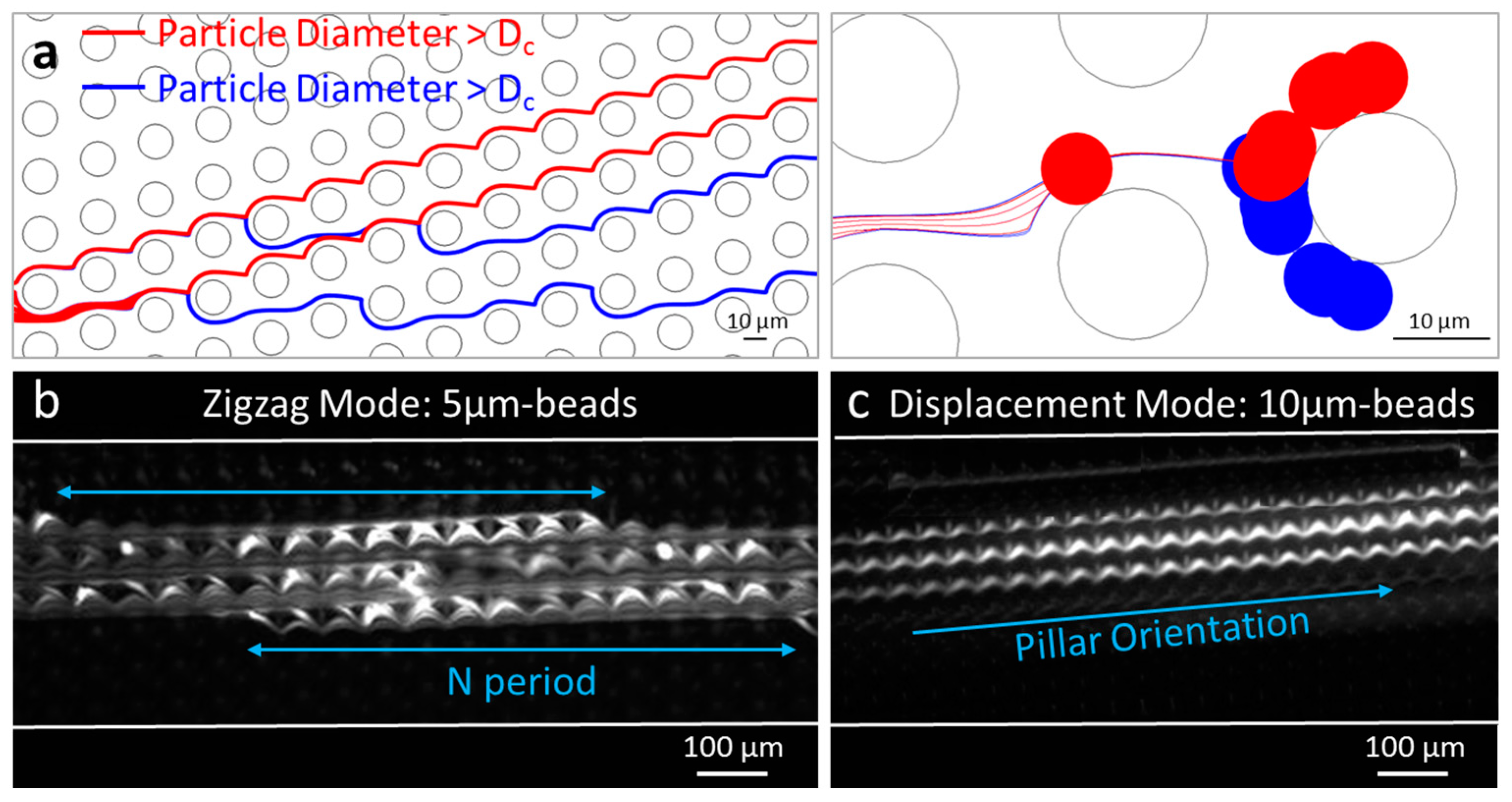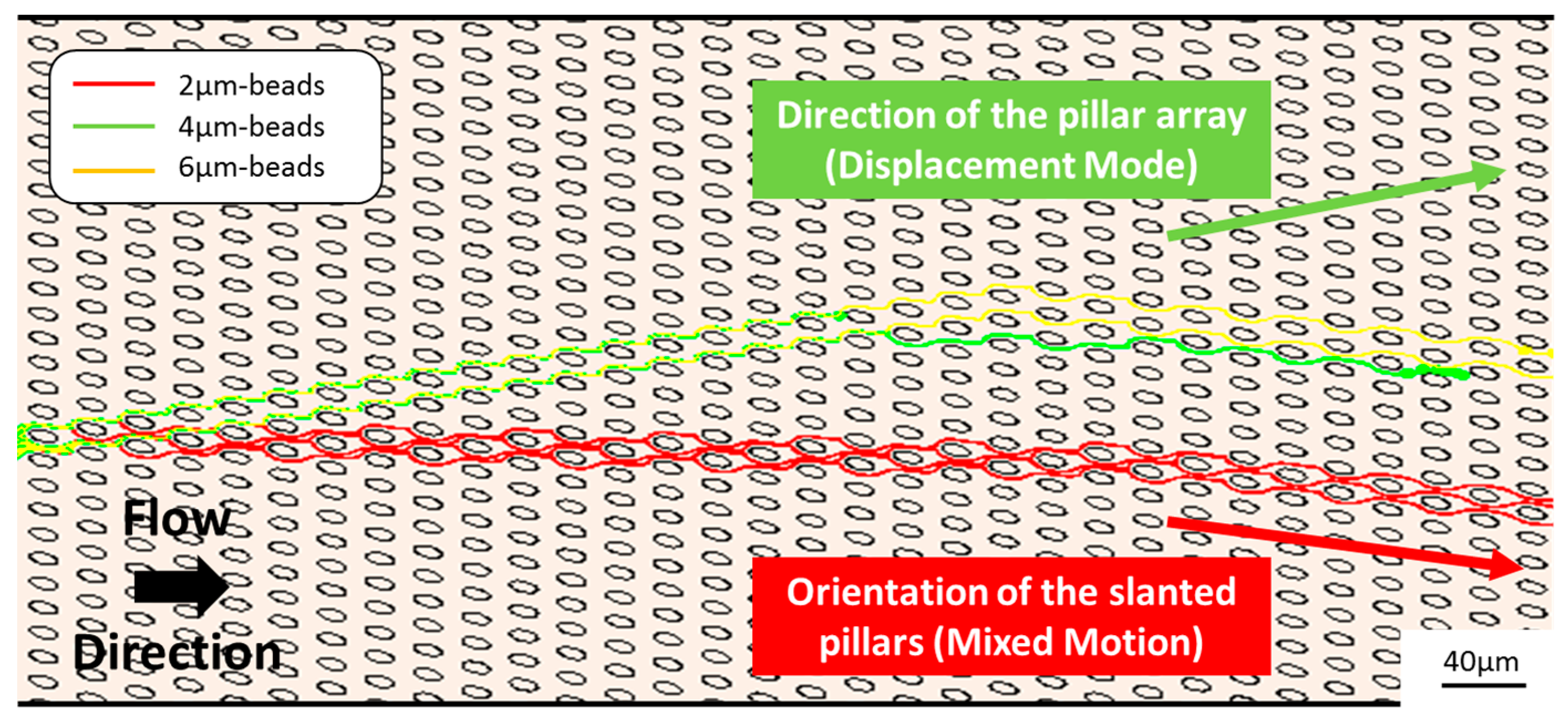Particle Separation with Deterministic Lateral Displacement (DLD): The Anisotropy Effect †
Abstract
:1. Introduction
2. Materials and Methods
3. Results
3.1. Numerical and Experimental Validation of DLD Separation
3.2. Influence of the Anisotropy Effect on the Particle Separation
3.3. Parametric Study of the Anisotropy Magnitude
4. Discussion
Acknowledgments
Conflicts of Interest
References
- Inglis, D.W.; Davis, J.A.; Austin, R.H.; Sturm, J.C. Critical particle size for fractionation by deterministic lateral displacement. Lab. Chip 2006, 6, 655–658. [Google Scholar] [CrossRef] [PubMed]
- Loutherback, K.; Chou, K.S.; Newman, J.; Puchalla, J.; Austin, R.H.; Sturm, J.C. Crossing microfluidic streamlines to lyse, label and wash cells. Microfluid. Nanofluidics 2010, 9, 1143–1149. [Google Scholar] [CrossRef]
- Wei, J.; Song, H.; Shen, Z.; He, Y.; Xu, X.; Zhang, Y.; Li, B.N. Numerical Study of Pillar Shapes in Deterministic Lateral Displacement Microfluidic Arrays for Spherical Particle Separation. IEEE Trans. Nanobiosci. 2015, 14, 660–667. [Google Scholar] [CrossRef] [PubMed]
- Kim, B.; Choi, Y.J.; Seo, H.; Shin, E.-C.; Choi, S. Deterministic Migration-Based Separation of White Blood Cells. Small 2016, 12, 5159–5168. [Google Scholar] [CrossRef] [PubMed]
- Okano, H.; Konishi, T.; Suzuki, T.; Suzuki, T.; Ariyasu, S.; Aoki, S.; Abe, R.M. Separation of viable and nonviable mammalian cells using a deterministic lateral displacement microfluidic device. Hayase Biomed. Microdevices 2015, 17, 59. [Google Scholar] [CrossRef] [PubMed]
- Wunsch, B.H.; Smith, J.T.; Gifford, S.M.; Wang, C.; Brink, M.; Bruce, R.L.; Austin, R.H.; Stolovitzky, G.; Astier, Y. Nanoscale lateral displacement arrays for the separation of exosomes and colloids down to 20nm. Nat. Nanotechnol. 2016, 11, 936–940. [Google Scholar] [CrossRef] [PubMed]
- Pariset, E.; Agache, V.; Millet, A. Extracellular Vesicles: Isolation Methods. Adv. Biosyst. 2017, 1, 1700040. [Google Scholar] [CrossRef] [PubMed]
- Kulrattanarak, T.; van der Sman, R.G.M.; Schroën, C.G.P.H.; Boom, R.M. Analysis of mixed motion in deterministic ratchets via experiment and particle simulation. Microfluid. Nanofluidics 2010, 10, 843–853. [Google Scholar] [CrossRef]
- Kulrattanarak, T.; van der Sman, R.G.M.; Lubbersen, Y.S.; Schroën, C.G.P.H.; Pham, H.T.M.; Sarro, P.M.; Boom, R.M. Mixed motion in deterministic ratchets due to anisotropic permeability. J. Colloid Interface Sci. 2011, 354, 7–14. [Google Scholar] [CrossRef] [PubMed]
- Vernekar, R.; Krüger, T.; Loutherback, K.; Morton, K.; Inglis, D. Anisotropic permeability in deterministic lateral displacement arrays. Phys. Fluid Dyn. 2016, arXiv:1610.08427v1. [Google Scholar] [CrossRef] [PubMed]
- Zeming, K.K.; Salafi, T.; Chen, C.-H.; Zhang, Y. Asymmetrical Deterministic Lateral Displacement Gaps for Dual Functions of Enhanced Separation and Throughput of Red Blood Cells. Sci. Rep. 2016, 6, 22934. [Google Scholar] [CrossRef] [PubMed]
- Bronstein, A.M.; Bronstein, M.M.; Kimmel, R. Generalized multidimensional scaling: A framework for isometry-invariant partial surface matching. J. Comput. Phys. 2007, 225, 771–784. [Google Scholar] [CrossRef]



Publisher’s Note: MDPI stays neutral with regard to jurisdictional claims in published maps and institutional affiliations. |
© 2017 by the authors. Licensee MDPI, Basel, Switzerland. This article is an open access article distributed under the terms and conditions of the Creative Commons Attribution (CC BY) license (https://creativecommons.org/licenses/by/4.0/).
Share and Cite
Pariset, E.; Berthier, J.; Pudda, C.; Navarro, F.; Icard, B.; Agache, V. Particle Separation with Deterministic Lateral Displacement (DLD): The Anisotropy Effect. Proceedings 2017, 1, 313. https://doi.org/10.3390/proceedings1040313
Pariset E, Berthier J, Pudda C, Navarro F, Icard B, Agache V. Particle Separation with Deterministic Lateral Displacement (DLD): The Anisotropy Effect. Proceedings. 2017; 1(4):313. https://doi.org/10.3390/proceedings1040313
Chicago/Turabian StylePariset, Eloise, Jean Berthier, Catherine Pudda, Fabrice Navarro, Béatrice Icard, and Vincent Agache. 2017. "Particle Separation with Deterministic Lateral Displacement (DLD): The Anisotropy Effect" Proceedings 1, no. 4: 313. https://doi.org/10.3390/proceedings1040313




